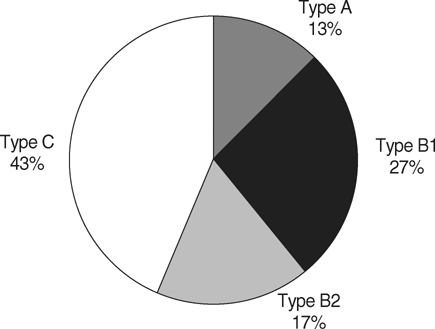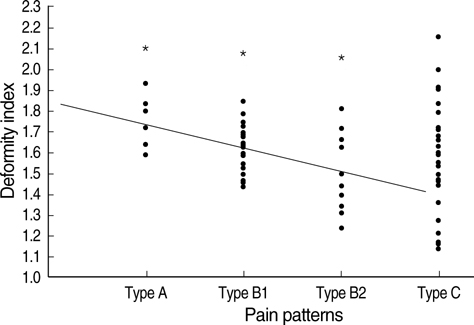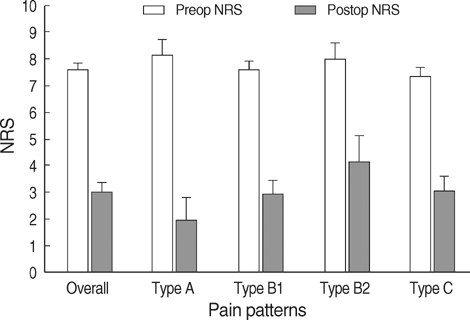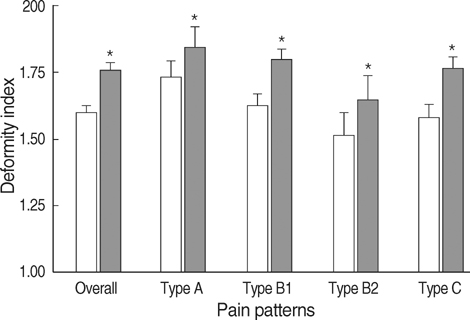J Korean Med Sci.
2008 Dec;23(6):1005-1010. 10.3346/jkms.2008.23.6.1005.
Clinical Relevance of Pain Patterns in Osteoporotic Vertebral Compression Fractures
- Affiliations
-
- 1Department of Neurosurgery, Presbyterian Medical Center, Jeonju, Korea. hyoungihl@hotmail.com
- 2Department of Neurosurgery, Bundang CHA Hospital, Seongnam, Korea.
- KMID: 1107525
- DOI: http://doi.org/10.3346/jkms.2008.23.6.1005
Abstract
- Few studies have been conducted to explain the pain patterns resulting from osteoporotic vertebral compression fractures (OVCF). We analyzed pain patterns to elucidate the pain mechanism and to provide initial guide for the management of OVCFs. Sixty-four patients underwent percutaneous vertebroplasty (N=55) or kyphoplasty (N=9). Three pain patterns were formulized to classify pains due to OVCFs: midline paravertebral (Type A), diffuse paravertebral (Type B), and remote lumbosacral pains (Type C). The degree of compression was measured using scale of deformity index, kyphosis rate, and kyphosis angle. Numerical rating scores were serially measured to determine the postoperative outcomes. As vertebral body height (VBH) decreased, paravertebral pain became more enlarged and extended anteriorly (p<0.05). Type A and B patterns significantly showed the reverse relationship with deformity index (p<0.05), yet Type C pattern was not affected by deformity index. Postoperative pain severity was significantly improved (p<0.05), and patients with a limited pain distribution showed a more favorable outcome (p<0.05). The improvement was closely related with the restoration of VBH, but not with kyphosis rate or angle. Thus, pain pattern study is useful not only as a guide in decision making for the management of patients with OVCF, but also in predicting the treatment outcome.
MeSH Terms
-
Aged
Aged, 80 and over
Female
Fracture Fixation, Internal/methods
Fractures, Compression/etiology/radiography/*surgery
Humans
Kyphosis/therapy
Magnetic Resonance Imaging
Male
Middle Aged
Osteoporosis/*complications/diagnosis
Pain/etiology/*surgery
Pain Measurement
Pain, Postoperative/etiology
Polymethyl Methacrylate/administration & dosage/therapeutic use
Questionnaires
Sickness Impact Profile
Spinal Fractures/radiography/*surgery
Tomography, X-Ray Computed
Treatment Outcome
Figure
Cited by 2 articles
-
Unilateral Biportal Endoscopy as a Treatment for Acute Radiculopathy after Osteoporotic Lumbar Compression Fracture - A Case Report -
Hyoung Bok Kim, Hoon-Jae Chung
J Korean Soc Spine Surg. 2019;26(1):21-25. doi: 10.4184/jkss.2019.26.1.21.Clinical Analysis of Acute Radiculopathy after Osteoporotic Lumbar Compression Fracture
Do Eon Kim, Hyeun Sung Kim, Seok Won Kim, Hyun Sook Kim
J Korean Neurosurg Soc. 2015;57(1):32-35. doi: 10.3340/jkns.2015.57.1.32.
Reference
-
1. Melton LJ 3rd, Kallmes DF. Epidemiology of vertebral fractures: implications for vertebral augmentation. Acad Radiol. 2006. 13:538–545.
Article2. Wasnich RD. Vertebral fracture epidemiology. Bone. 1996. 18:3 Suppl. 179S–183S.
Article3. Ross PD. Clinical consequences of vertebral fractures. Am J Med. 1997. 103:Suppl. 30S–42S.
Article4. Galibert P, Deramond H. Percutaneous acrylic vertebroplasty as a treatment of vertebral angioma as well as painful and debilitating diseases. Chirurgie. 1990. 116:326–334.5. Jensen ME, Evans AJ, Mathis JM, Kallmes DF, Cloft HJ, Dion JE. Percutaneous polymethylmethacrylate vertebroplasty in the treatment of osteoporotic vertebral body compression fractures: technical aspects. Am J Neuroradiol. 1997. 18:1897–1904.6. Kim DH, Vaccaro AR. Osteoporotic compression fractures of the spine; current options and considerations for treatment. Spine J. 2006. 6:479–487.
Article7. Jung JH, Kim HI, Shin DA, Shin DG, Lee JO, Kim HJ, Chung JH. Usefulness of pain distribution pattern study in decision-making for the patients with lumbar zygapophyseal and sacroiliac joint arthropathy. J Korean Med Sci. 2007. 22:1021–1027.8. Dreyfuss P, Tibiletti C, Dreyer SJ. Thoracic zygapophyseal joint pain patterns. A study in normal volunteers. Spine. 1994. 19:807–811.9. O'Neill CW, Kurgansky ME, Derby R, Ryan DP. Disc stimulation and patterns of referred pain. Spine. 2002. 27:2776–2781.10. Takata K, Hirotani H. Pain drawing in the evaluation of low back pain. Int Orthop. 1995. 19:361–366.
Article11. Nakano M, Hirano N, Ishihara H, Kawaguchi Y, Watanabe H, Matsuura K. Calcium phosphate cement-based vertebroplasty compared with conservative treatment for osteoporotic compression fractures: a matched case-control study. J Neurosurg Spine. 2006. 4:110–117.
Article12. Cortet B, Cotten A, Boutry N, Flipo RM, Duquesnoy B, Chastanet P, Delcambre B. Percutaneous vertebroplasty in the treatment of osteoporotic vertebral compression fractures: an open prospective study. J Rheumatol. 1999. 26:2222–2228.13. Deramond H, Saliou G, Aveillan M, Lehmann P, Vallee JN. Respective contributions of vertebroplasty and kyphoplasty to the management of osteoporotic vertebral fractures. Joint Bone Spine. 2006. 73:610–613.14. Pateder DB, Khanna AJ, Lieberman IH. Vertebroplasty and kyphoplasty for the management of osteoporotic vertebral compression fractures. Orthop Clin North Am. 2007. 38:409–418.
Article15. Kelgren J. On the distribution of pain arising from deep somatic structures with charts of segmental pain area. Clin Sci. 1939. 4:35–46.16. Feinstein B, Langton JN, Jameson RM, Schiller F. Experiments of pain referred from deep somatic tissues. J Bone Joint Surg Am. 1954. 36-A:981–997.17. Schellhas KP, Pollei SR, Dorwart RH. Thorasic discography. A safe and reliable technique. Spine. 1994. 19:2103–2109.18. Wood KB, Blair JM, Aepple DM, Aschendel MJ, Garvey TA. The natural history of asymptomatic thorasic disc herniations. Spine. 1997. 22:525–529.19. Bogduk N. The innervation of the lumbar spine. Spine. 1983. 8:286–293.
Article20. Bogduk N, Tynan W, Wilson A. The nerve supply to the human lumbar intervertebral disc. J Anat. 1981. 132:39–56.21. Bonica JJ. Bonica JJ, editor. Applied anatomy relevant to pain. The management of pain. 1990. 2nd ed. Philadelphia: Lea & Febiger;133–158.22. Dean JR, Ison KT, Gishen P. The strengthening effect of percutaneous vertebroplasty. Clin Radiol. 2000. 55:471–476.
Article23. Maynard AS, Jensen ME, Schweickert PA, Marx WF, Short JG, Kallmes DF. Value of bone scan imaging in predicting pain relief from percutaneous vertebroplasty in osteoporotic vertebral fractures. Am J Neuroradiol. 2000. 21:1807–1812.24. San Millan Ruiz D, Burkhardt K, Jean B, Muster M, Martin JB, Bouvier J, Fasel JH, Rufenacht DA, Kurt AM. Pathology findings with acrylic implants. Bone. 1999. 25:Suppl 2. 85S–90S.
Article25. Levine SA, Perin LA, Hayes D. An evidence-based evaluation of percutaneous vertebroplasy. Manag Care. 2000. 9:56–60. 6326. Barr JD, Barr MS, Lemley TJ, McCann RM. Percutaneous vertebroplasty for pain relief and spinal stabilization. Spine. 2000. 25:923–928.
Article27. Hiwatashi A, Motitani T, Numaguchi Y, Westesson PL. Increase in vertebral height after vertebroplasty. Am J Neuroradiol. 2003. 23:185–189.28. Shindle MK, Gardner MJ, Koob J, Bukata S, Cabin JA, Lane JM. Vertebral height restoration in osteoporotic compression fractures: kyphoplasty balloon tamp is superior to postural correction alone. Osteoporos Int. 2006. 17:1815–1819.
Article29. Alvarez L, Perez-Higueras A, Granizo JJ, de Miguel I, Quinones D, Rossi RE. Predictors of outcomes of percutaneous vertebroplasty for osteoporotic vertebral fractures. Spine. 2005. 30:87–92.
Article30. Chandler G, Dalley G, Hemmer J, Seely T. Gray rami communicans nerve block: novel treatment approach for painful osteoporotic vertebral compression fracture. South Med J. 2001. 94:387–393.31. Kim YG, Kim KH, Kim CH, Shin SW, Kwon JY, Kim HK, Baik SW. Percutaneous vertebroplasty and facet joint block. J Korean Med Sci. 2005. 20:1023–1028.
Article32. Schellhas KP, Pollei SR, Doewart RH. Thorasic discography: a safe and reliable technique. Spine. 1994. 19:2103–2109.
- Full Text Links
- Actions
-
Cited
- CITED
-
- Close
- Share
- Similar articles
-
- Vertebroplasty in the Multiple Osteoporotic Compression Fracture
- Percutaneous Vertebroplasty for Pregnancy-Associated Osteoporotic Vertebral Compression Fractures
- Spontaneous Height Restoration of Vertebral Compression Fracture: A Case Report
- Unilateral Biportal Endoscopy as a Treatment for Acute Radiculopathy after Osteoporotic Lumbar Compression Fracture: A Case Report
- Long Term Follow-up of Osteoporotic Vertebral Fractures According to the Morphologic Analysis of Fracture Pattern







